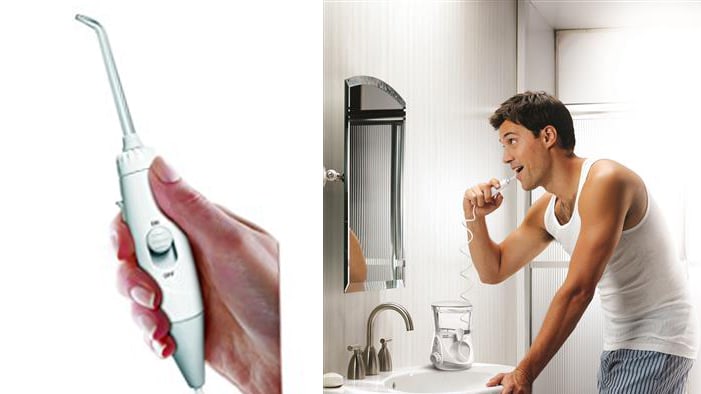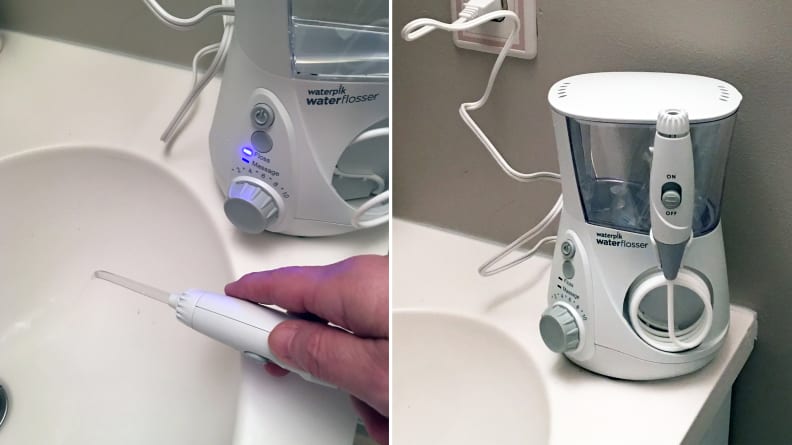This is the secret to keeping your teeth perfectly clean—without flossing
It's a shortcut that could even save your life
Products are chosen independently by our editors. Purchases made through our links may earn us a commission.
You might think of a water flosser as a nice little luxury, something akin to a towel heater or an aromatherapy diffuser: a nice-to-have, but not a necessity. That’s where you’re wrong.
It turns out that using a water flosser—which uses a thin jet of water instead of string to clean between your teeth and below your gum line—might just lessen your chance of heart attack of blood clots. According to a report by Harvard Medical School, that’s because plaque and bacteria in your mouth can travel to your heart.
Caring for your teeth impacts your whole health (just like mom always said). Take it from me: I somehow developed periodontitis, which means pockets between my teeth and gums that led to bacteria build-up and infection. The deep cleaning by a periodontist that followed is nothing I’d want to repeat. It hurts!
After my cleaning, my dentist advised me to use a Waterpik to maintain my oral health. “Research studies show that even the string floss is not as effective as a Waterpik,” said Dr. Kumar T Vadivel, a board certified periodontist and gum specialist in Carrollton, Texas. “It removes the plaque in between the teeth more effectively than anything else. I highly recommend it.”
I’d had a bad experience with a water flosser about 10 years ago and was not hopeful this time around, either: but the Waterpik Aquarius Waterflosser ($69) proved me wrong.
Trying out the Waterpik Aquarius

The first water flosser I used came with one all-purpose tip and was so large it would barely fit on my bathroom sink. A flip of the on-switch brought the machine to life with a roar of the engine, and the water that pumped through the tip sprayed everywhere. The mess and the instability of the unit convinced me that a water flosser wasn't right for me.
That’s until the Waterpik Aquarius landed on my doorstep: the sleek product comfortably fits on my small bathroom sink and comes with seven tips, each with a different purpose from a standard toothbrush head to an orthodontic tip to maneuver around braces.
I purposely didn't read the directions to gauge the intuitiveness of the flosser—I assembled it with no hassle. The oral irrigator attaches by tube to a water reservoir, which pumps through the flosser and into you mouth in a super-fine stream. When I flipped the power on, I immediately noticed the purr of the engine is much softer than the roar of older water flosser models, but it’s far from silent. It’s probably best not to use it when people are sleeping nearby.

On first use, I was surprised by the water pressure on the Waterpik: it is strong. It has pressure settings from 1 through 10, and Dr. Vadivel said that although 10 is the optimal force to use eventually, he recommends patients start at level one and gradually build up as your gums get used to the pressure.
Like a great electric toothbrush, it’s important to use a water flosser with a timer and prompts so that you know when it’s time to move to a new quadrant of your mouth. Luckily, the Aquarius has a one-minute timer and 30-second pacer to help you floss efficiently and for the requisite amount of time.
The toggle switch on the handle comes in handy—it allows you to turn the machine off and keep all your settings ready to go, because sometimes you just need to stop for a minute when the doorbell rings or the baby cries.
The many attachments on the Waterpik Aquarius
On my first try, I tried the classic jet tip which is universally great whether you have braces, dentures, or anything in between. This tip looks like a tiny faucet, and three are included with the flosser so there are separate ones for each person in a household.
The toothbrush tip pushes water through the brush to clean and rinse teeth, allowing you to brush and water floss at the same time.. Dr. Vadivel highly recommends this attachment because it gives a superior cleaning to a regular toothbrush or even an electric toothbrush, since it’s able to floss your teeth at the same time.
The plaque seeker tip is useful for anyone but especially those with crowns, implants, bridges and retainers. It looks like a toothbrush but with only three main bristles. If you have had dental restorations, you know that debris works its way under and behind them. The plaque seeker tip sprays water under and around those hard-to-reach places, loosening and expelling debris.
The orthodontic tip is great for anyone with braces, since it’s designed to reach around braces but not become caught in them. The tip almost looks like a flat-capped ballpoint pen, and is designed to removes hard-to-reach plaque around orthodontic brackets and wires.
The Pik pocket tip is perfect for those with periodontal problems (me!) or furcation (bone loss impacting the root —me again!) because the attachment looks more needle-like than the others, meaning it can reach into pockets between your teeth and gums.
The tongue cleaner is shaped like a traditional tongue scraper, but has a gentle scraping and flushing action to remove bacteria that build up on your tongue.
Do you need a Waterpik?
According to the experts, yes, everyone should use a water flosser. Used regularly, it will inevitably improve your oral health and even prevent serious illnesses like heart attacks and stokes. Personally, I was impressed with its sleek design and its ease of use.
However, even if you use a Waterpik Aquarius—Dr. Vadivel’s preferred water flosser for thoroughness and convenience––there’s an important caveat: “Nothing takes the place of regular professional cleanings,” he said. “But using this Waterpik is absolutely the best thing you can do for your dental health.”
